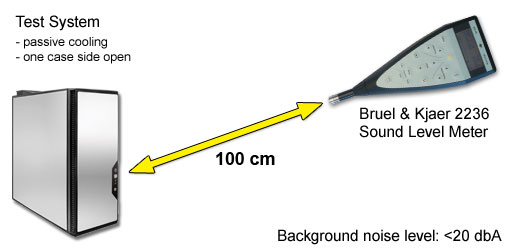 36
36
MSI GTX 770 TwinFrozr Gaming 2 GB Review
Performance Summary »Fan Noise
In past years, gamers would accept everything for a little bit more performance. Nowadays, users are more aware of the fan noise and the power consumption of their graphics cards.In order to properly test the fan noise that a card emits, we use the Bruel & Kjaer 2236 sound-level meter (~$4,000). It has the measurement range and the accuracy we are looking for.

The tested graphics card was installed in a system that was completely cooled passively. That is, passive PSU, passive CPU cooler, and passive cooling on the motherboard and on a solid state drive. Noise results of other cards on this page are measurements of the respective reference design.
This setup allows us to eliminate secondary noise sources and test only the video card. To be more compliant with standards like DIN 45635 (we are not claiming to be fully DIN 45635 certified), the measurement was conducted at a distance of 100 cm and 160 cm off the floor. The ambient background noise level in the room was well below 20 dBA for all measurements. Please note that the dBA scale is not linear but logarithmic. 40 dBA is not twice as loud as 20 dBA. A 3 dBA increase results in double the sound pressure. The human hearing perception is a bit different, and it is generally accepted that a 10 dBA increase doubles the perceived sound level. The 3D load noise levels were tested with a stressful game, not with Furmark.
MSI did a fantastic job with the noise levels of their GTX 770 Gaming. In idle, the card is almost inaudible on an open bench in a quiet room with no other fans. It will certainly be inaudible in a modern case with other fans present.
During gaming, the fan ramps up just a little bit to handle the increased thermal load, but it doesn't get noisy at all. Especially the gaming-noise levels are impressive--much better than any other custom design GTX 770 we've reviewed so far.
Even with such a quiet fan, the card stays below 79°C under load, which prevents any of NVIDIA's additional throttling at 80°C.


Feb 5th, 2025 09:52 EST
change timezone
Latest GPU Drivers
New Forum Posts
- RTX 5090 ridiculous price! (154)
- Immortals of Aveum deserves a second chance, the new free demo has convinced me. (59)
- What's your latest tech purchase? (23070)
- QVL - Myth, Legend, Marketing/Advertising, what is your take? (104)
- RTX5000 Series Owners Club (47)
- Dear AMD, NVIDIA, INTEL and others, we need cheap (192-bit to 384-bit), high VRAM, consumer, GPUs to locally self-host/inference AI/LLMs (63)
- 5090 ROG Astral LC Temps, clocks and info. (4)
- What fixed stuttering and random framerate spikes in games for me (28)
- What are you playing? (22756)
- Astral 5080 Power limit (13)
Popular Reviews
- Spider-Man 2 Performance Benchmark Review - 35 GPUs Tested
- Corsair Frame 4000D Review
- NVIDIA GeForce RTX 5080 Founders Edition Review
- Gigabyte GeForce RTX 5080 Gaming OC Review
- MSI GeForce RTX 5080 Vanguard SOC Review
- AMD Ryzen 7 9800X3D Review - The Best Gaming Processor
- ASUS GeForce RTX 5080 Astral OC Review
- Cooler Master X Silent Edge Platinum 850 W Review - Fully Passive PSU
- NVIDIA DLSS 4 Transformer Review - Better Image Quality for Everyone
- NVIDIA GeForce RTX 5090 Founders Edition Review - The New Flagship
Controversial News Posts
- NVIDIA 2025 International CES Keynote: Liveblog (470)
- AMD Debuts Radeon RX 9070 XT and RX 9070 Powered by RDNA 4, and FSR 4 (349)
- AMD Radeon 9070 XT Rumored to Outpace RTX 5070 Ti by Almost 15% (282)
- AMD is Taking Time with Radeon RX 9000 to Optimize Software and FSR 4 (256)
- AMD Denies Radeon RX 9070 XT $899 USD Starting Price Point Rumors (239)
- Edward Snowden Lashes Out at NVIDIA Over GeForce RTX 50 Pricing And Value (235)
- AMD Radeon RX 9070 XT & RX 9070 Custom Models In Stock at European Stores (226)
- New Leak Reveals NVIDIA RTX 5080 Is Slower Than RTX 4090 (215)
